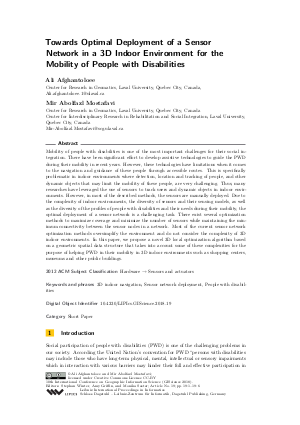Towards Optimal Deployment of a Sensor Network in a 3D Indoor Environment for the Mobility of People with Disabilities (Short Paper)
Authors Ali Afghantoloee, Mir Abolfazl Mostafavi
-
Part of:
Volume:
10th International Conference on Geographic Information Science (GIScience 2018)
Part of: Series: Leibniz International Proceedings in Informatics (LIPIcs)
Part of: Conference: International Conference on Geographic Information Science (GIScience) - License:
 Creative Commons Attribution 3.0 Unported license
Creative Commons Attribution 3.0 Unported license
- Publication Date: 2018-08-02
File

PDF
LIPIcs.GISCIENCE.2018.19.pdf
- Filesize: 295 kB
- 6 pages
Document Identifiers
Subject Classification
ACM Subject Classification
- Hardware → Sensors and actuators
Keywords
- 3D indoor navigation
- Sensor network deployment
- People with disabilities
Metrics
- Access Statistics
-
Total Accesses (updated on a weekly basis)
0Document
0Metadata
Abstract
Mobility of people with disabilities is one of the most important challenges for their social integration. There have been significant effort to develop assistive technologies to guide the PWD during their mobility in recent years. However, these technologies have limitations when it comes to the navigation and guidance of these people through accessible routes. This is specifically problematic in indoor environments where detection, location and tracking of people, and other dynamic objects that may limit the mobility of these people, are very challenging. Thus, many researches have leveraged the use of sensors to track users and dynamic objects in indoor environments. However, in most of the described methods, the sensors are manually deployed. Due to the complexity of indoor environments, the diversity of sensors and their sensing models, as well as the diversity of the profiles of people with disabilities and their needs during their mobility, the optimal deployment of a sensor network is a challenging task. There exist several optimization methods to maximize coverage and minimize the number of sensors while maintaining the minimum connectivity between the sensor nodes in a network. Most of the current sensor network optimization methods oversimplify the environment and do not consider the complexity of 3D indoor environments. In this paper, we propose a novel 3D local optimization algorithm based on a geometric spatial data structure that takes into account some of these complexities for the purpose of helping PWD in their mobility in 3D indoor environments such as shopping centers, museums and other public buildings.
Cite As Get BibTex
Ali Afghantoloee and Mir Abolfazl Mostafavi. Towards Optimal Deployment of a Sensor Network in a 3D Indoor Environment for the Mobility of People with Disabilities (Short Paper). In 10th International Conference on Geographic Information Science (GIScience 2018). Leibniz International Proceedings in Informatics (LIPIcs), Volume 114, pp. 19:1-19:6, Schloss Dagstuhl – Leibniz-Zentrum für Informatik (2018)
https://doi.org/10.4230/LIPIcs.GISCIENCE.2018.19
BibTex
@InProceedings{afghantoloee_et_al:LIPIcs.GISCIENCE.2018.19,
author = {Afghantoloee, Ali and Mostafavi, Mir Abolfazl},
title = {{Towards Optimal Deployment of a Sensor Network in a 3D Indoor Environment for the Mobility of People with Disabilities}},
booktitle = {10th International Conference on Geographic Information Science (GIScience 2018)},
pages = {19:1--19:6},
series = {Leibniz International Proceedings in Informatics (LIPIcs)},
ISBN = {978-3-95977-083-5},
ISSN = {1868-8969},
year = {2018},
volume = {114},
editor = {Winter, Stephan and Griffin, Amy and Sester, Monika},
publisher = {Schloss Dagstuhl -- Leibniz-Zentrum f{\"u}r Informatik},
address = {Dagstuhl, Germany},
URL = {https://drops.dagstuhl.de/entities/document/10.4230/LIPIcs.GISCIENCE.2018.19},
URN = {urn:nbn:de:0030-drops-93471},
doi = {10.4230/LIPIcs.GISCIENCE.2018.19},
annote = {Keywords: 3D indoor navigation, Sensor network deployment, People with disabilities}
}
Author Details
References
-
A Afghantoloee, S Doodman, F Karimipour, and M A Mostafavi. Coverage Estimation of Geosensor in 3d Vector Environments. The International Archives of Photogrammetry, Remote Sensing and Spatial Information Sciences, 40(2):1, 2014.

-
Vahab Akbarzadeh, Christian Gagné, Marc Parizeau, Meysam Argany, and Mir Abolfazl Mostafavi. Probabilistic sensing model for sensor placement optimization based on line-of-sight coverage. IEEE Transactions on Instrumentation and Measurement, 62(2):293-303, 2013.

-
Meysam Argany. Development of a GIS-Based Method for Sensor Network Deployment and Coverage Optimization. PhD thesis, Université Laval, 2015.

-
Francois-Michel De Rainville, Christian Gagné, and Denis Laurendeau. Automatic Sensor Placement For Complex Three-dimensional Inspection and Exploration.

-
Patrick Fougeyrollas, René Cloutier, Hélène Bergeron, Ginette St-Michel, Jacques Côté, Marcel Côté, Normand Boucher, Kathia Roy, and Marie-Blanche Rémillard. The Quebec classification: Disability creation process. Québec RIPPH/SCCIDIH,, 1998.

-
Melvyn Colin Freeman, Kavitha Kolappa, Jose Miguel Caldas de Almeida, Arthur Kleinman, Nino Makhashvili, Sifiso Phakathi, Benedetto Saraceno, and Graham Thornicroft. Convention on the Rights of Persons with Disabilities, 2015.

-
M Amac Guvensan and A Gokhan Yavuz. On coverage issues in directional sensor networks: A survey. Ad Hoc Networks, 9(7):1238-1255, 2011.

-
Chi-Fu Huang and Yu-Chee Tseng. The coverage problem in a wireless sensor network. Mobile Networks and Applications, 10(4):519-528, 2005.

-
Raghavendra V Kulkarni and Ganesh Kumar Venayagamoorthy. Particle swarm optimization in wireless-sensor networks: A brief survey. IEEE Transactions on Systems, Man, and Cybernetics, Part C (Applications and Reviews), 41(2):262-267, 2011.

-
Guiling Wang, Guohong Cao, and Thomas F La Porta. Movement-assisted sensor deployment. IEEE Transactions on Mobile Computing, 5(6):640-652, 2006.

-
Yao Zou and Krishnendu Chakrabarty. Sensor deployment and target localization based on virtual forces. In INFOCOM 2003. Twenty-Second Annual Joint Conference of the IEEE Computer and Communications. IEEE Societies, volume 2, pages 1293-1303. IEEE, 2003.

